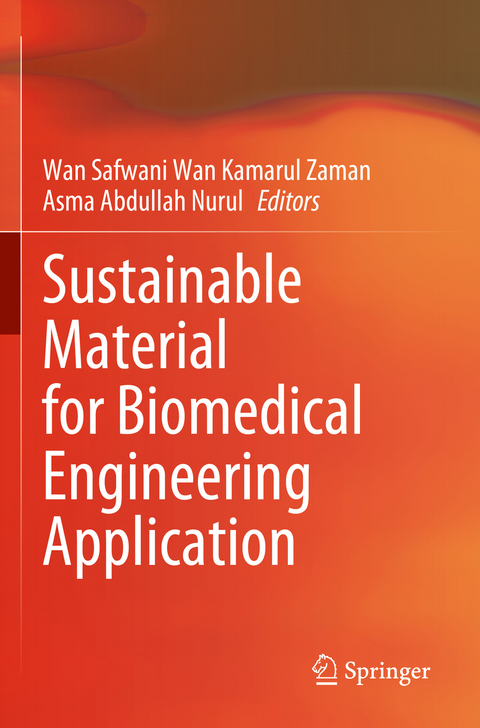
Sustainable Material for Biomedical Engineering Application
Springer Verlag, Singapore
978-981-99-2269-7 (ISBN)
- Titel nicht im Sortiment
- Artikel merken
Dr Wan Safwani Binti Wan Kamarul Zaman is currently a senior lecturer in the Department of Biomedical Engineering, Faculty of Engineering, University of Malaya, Malaysia. She is also a registered pharmacist under the Pharmacy Board of Malaysia. Her research interest is in regenerative medicine and tissue engineering with specific interest in human mesenchymal stem cells (MSCs) and its biosafety and bioefficacy, MSCs biocompatibility in bioscaffold and the application of sustainable biomaterial in tissue engineering. She is an active reviewer for a number of national and international journals. She has more than 10 years of teaching experience in human anatomy and physiology, biochemistry and analysis and communication and thinking skills. Dr Wan Safwani has published more than 50 research articles in peer-reviewed international journal and authored or co-authored several book chapters. She is currently serving as an executive member of the Tissue Engineering and RegenerativeMedicine Society of Malaysia (TESMA). She is also a member of the Malaysian Pharmaceutical Society (MPS) and a member of Society of Medical and Biological Engineering Malaysia (MSMBE). She has also served as an advisory committee member for several conferences. Dr Asma Abdullah Nurul is an Associate Professor and the Head of the Biomedicine Department at the School of Health Sciences, University Science Malaysia. She has more than ten years of academic teaching experience in molecular biology, immunology, microbiology and stem cell and regenerative medicine. Dr Nurul has been engaged in multidisciplinary research which involves biomedicine, material engineering and clinical research in the field of tissue engineering and regenerative medicine. Her main current research interests include understanding the effects of immunomodulation on the molecular mechanism of osteogenic regeneration, development of biomaterials for hard-tissue engineering (dental, bone and cartilage),and cell-based and cell free therapy in regenerative medicine. Dr. Nurul is also an active reviewer for a number of international journals, as well as a reviewer for university and national grants. She has published over 60 full peer-reviewed papers in the related field and authored or co-authored several book chapters. In professional bodies, Dr. Nurul is an active member in various national and international societies. She is currently serving as an executive committee member of the Tissue Engineering and Regenerative Medicine Society Malaysia and the Malaysia Biomaterial Society.
Chapter 1. Utilisation of Human "Wastes" as Materials in Biomedical Engineering Application.- Chapter 2. The Green Approach Based Biomaterials for Tissue Engineering Application.- Chapter 3. Food Waste-Derived Sources: Synthesis, Properties and Applications in Biomedical Engineering.- Chapter 4. Malaysian Seashells Based Hydroxyapatite for Biomedical Application.- Chapter 5 . Chitosan from Marine Biowaste: Current and Future Applications in Tissue Engineering.-Chapter 6. Natural Hydroxyapatite from Black Tilapia Fish Bones and Scales for Biomedical Applications.- Chapter 7. Human Amnion as a Cell Delivery Vehicle for Tissue Engineering And Regenerative Medicine Applications.- Chapter 8. Bioscaffolds and Cell Source in Cartilage Tissue Engineering.- Chapter 9. Lipase Synthesis Using Palm Oil Mill Effluent for Polycaprolactone Production.- Chapter 10. Engineered Microbial Sensing Element-based Biosensor for Sustainable Biomedical Engineering Application.- Chapter 11. Progress in Biomedical Applications using Sustainable Nanoparticles.- Chapter 12. Development of Nanomaterials from Natural Resources for Biosensing and Biomedical Technology.- Chapter 13. 3D Bioprinted Scaffolds from Sustainable Materials for Tissue Engineering: Evolution and Current Challenges.- Chapter 14. Sustainable Biomaterials for 3D Printing.- Chapter 15. Biowaste as Candidates for Future Bone Materials.- Chapter 16. Hybrid bioscaffolds formation using natural and synthetic materials for cartilage tissue engineering: The case of fibrin, atelocollagen and poly(lactic-co-glycolic acid).- Chapter 17. Sustainable Design of Natural and Synthetic Biomaterials for Wound Healing Applications.- Chapter 18. Polysaccharide-Based Injectable Nanocomposite Hydrogels for Wound Healing Application.- Chapter 19. Roles of Sustainable Biomaterials in Biomedical Engineering for Ischemic Stroke Therapy.- Chapter 20. Sustainable Materials for Biomedical Engineering Application in Dentistry.- Chapter 21. Glass Ionomer Cements as Sustainable Material for Restorative Dentistry.- Chapter 22. Mapping The Ethical and Regulatory Issues Of 3D Bioprinting Using Biomaterials in A Low- And Middle-Income Nation: Malaysian Perspectives.- Chapter 23. Ethical And Regulatory Considerations for Sustainable Practices in Biomedical Applications.
| Erscheinungsdatum | 11.08.2024 |
|---|---|
| Zusatzinfo | 1 Illustrations, black and white; XVII, 499 p. 1 illus. |
| Verlagsort | Singapore |
| Sprache | englisch |
| Maße | 155 x 235 mm |
| Themenwelt | Medizin / Pharmazie ► Physiotherapie / Ergotherapie ► Orthopädie |
| Technik ► Maschinenbau | |
| Technik ► Medizintechnik | |
| Technik ► Umwelttechnik / Biotechnologie | |
| Schlagworte | biomedical engineering • biowaste • Green Technology • Nature-inspired Biomass • Sustainability Materials • Tissue engineering |
| ISBN-10 | 981-99-2269-0 / 9819922690 |
| ISBN-13 | 978-981-99-2269-7 / 9789819922697 |
| Zustand | Neuware |
| Haben Sie eine Frage zum Produkt? |
aus dem Bereich


